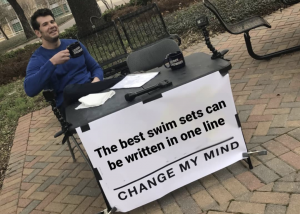My swimming has come a long way over my nine years as a pro triathlete. Look no further than the trajectory of my PTO ranking in the swim. Swimming was my weakest discipline and a major liability for most of my pro career. I couldn’t imagine every truly loving it. I grudgingly shifted my focus to swimming in 2022 after a couple years of erratic pool access during the pandemic. Before long—and much to my shock—I’d fallen hard for swimming. Why was the pool my new favourite place to be?

I’ve experimented a lot with swim training methods and learned from some of the best. Here are the principles that have been most effective for me:
Swim with others. I’ll gladly do most of my bike/run training solo, but swimming feels fundamentally different. After spending the first several years of my tri career swimming entirely alone, finding swim training partners gave me an immediate boost. I’m willing to be flexible with my entire swim program if it means having company. I’m notorious for sauntering out onto the pool deck, asking a few friends what their sets are, then jumping in whichever best matches my needs, even if it means skipping a warmup!
Swim frequently. I aim for 6 swims per week for most of the year (usually ~30,000 meters total). I’ve noticed a tight correlation between frequency and feel for the water. I feel noticeably rusty even after two consecutive days out of the water. Pandemic pool closures forced me to experiment with a couple monster swims per week instead of consistent daily swims. The results were rough! I’ll also admit that I don’t mess with double swim days anymore… partly because there is no experience more soul-crushing than slipping back into a damp speedo that I forgot to swap.

Include quality every session. I hit 3 or 4 harder main sets each week, but even the “easy” days include a little speed, band or paddles. For the main sets, I usually aim for a 7/10 overall effort level (not necessarily perceived exertion). I’ll go a little closer to failure or “best average” in one set per week. I’d rather stack up consistent, quality sets than occasional epic ones.
Avoid slow swimming. Moving quickly through the water is fundamentally different than swimmingly slowly in terms of feel. Most of my swim training is near race-specific pace or intensity (~1:10–1:20/100m). Even warmups, cooldowns and easy days are rarely slower than 1:25/100m. My rationale is that slower swimming engrains suboptimal technique while faster swimming reinforces technique applicable to racing fast. My thinking here was partly inspired by the extreme training regime of speed skating Olympic gold medalist Nils van der Poel, who did virtually all his on-ice training at race-specific speeds. I think this concept is applicable to other highly technical sports like swimming. On the other hand, I’m happy to run as slow as I feel like!
Avoid most drills and “technique” focused sets or blocks. Like most triathletes, I’ve tried slowing down and breaking down my stroke to work on technique. I now believe that this is an utter waste of time, and maybe even counterproductive. “Technique under load” is a critical principle that I picked up from triathlon swim coach Tim Floyd. It’s the idea that technique and training (or intensity) don’t exist independently; you need to work on both simultaneously. With this in mind, I only do a couple specific drills during some warm-ups or cool-downs. I make sure I understand why I’m doing a particular drill.
Swim mindfully. Remaining focused and aware of how my body moves through the water has been more productive than any drill. This takes a deliberate effort, since it’s easier to switch off during workouts. I use my commute to the pool to set my intention and focus for the swim practice. On the other hand, I wrote this entire post while spinning at 200 watts on the trainer. Compared to swimming, the motion of cycling has fewer degrees of freedom and therefore doesn’t demand nearly as much focus to hold form.
Open water swimming is overrated*. My swim fitness is built in the pool. I just hit a couple open water swims before races to brush up on specific technical elements (e.g., positioning, sighting, starts/exits, buoys, waves). Granted, I’ve accumulated a ton of open water experience. *The major caveat here is that you must spend enough time swimming in open water to feel very comfortable. Even accomplished pool swimmers aren’t immune to open water freak-outs!

Embrace repetition and simplicity. My go-to swim sets are written in one line and repeated again and again. What is it with triathletes and elaborate sets that take a full white board to write out?! I try to get my kicks from perfecting a highly repetitive process, not from constant novelty.
I highly recommend Joel Filliol’s “Top 20 Rules for Faster Triathlon Swimming“. I revisit this classic blog post every year and it continues to ring true.
I’ll forever be a student of the water and I’ll continue to adapt my approach as I learn. Let me know what’s worked for you!









